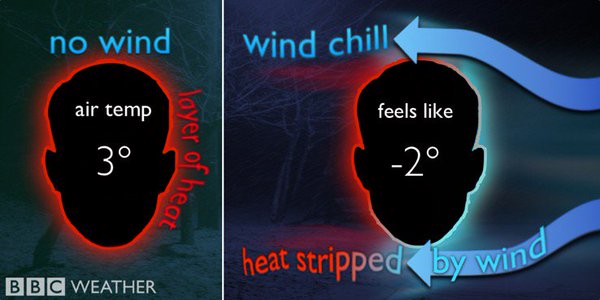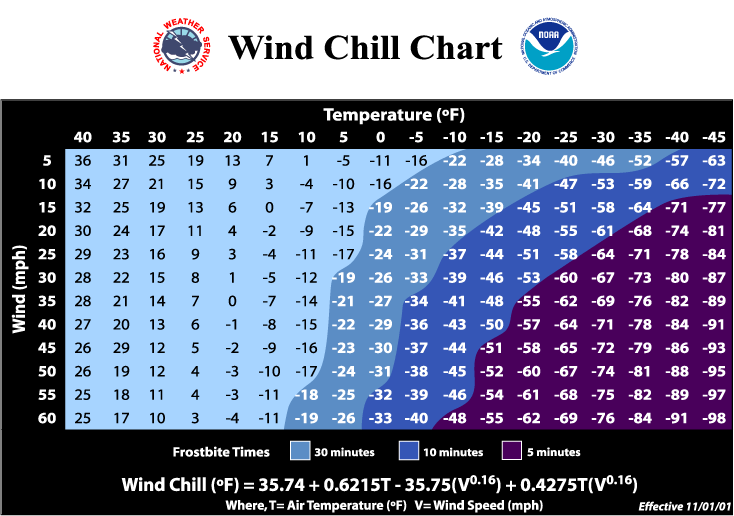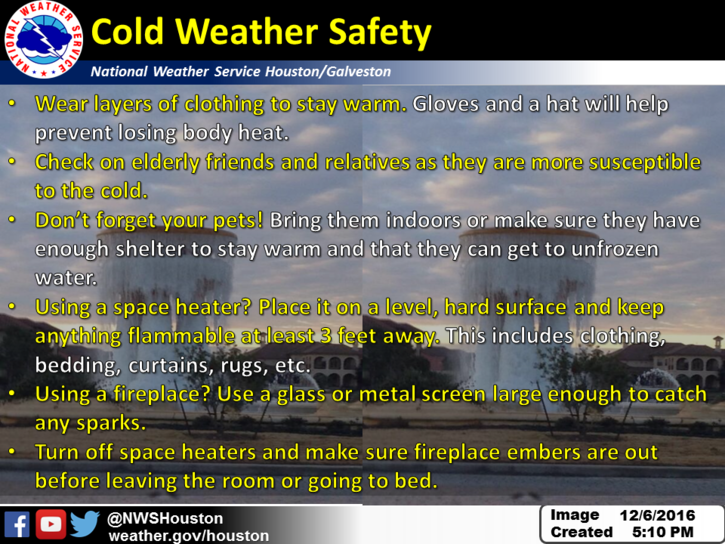Earlier this summer, I wrote one of our first ‘weather why’ pieces on the heat index. Now that Eric has written the obituary for Summer 2016 (RIP), we can discuss the heat index’s winter cousin—the wind chill. Since regional wind chill temperatures could fall into the upper teens tonight, it’s important to understand how wind chill works.
What is wind chill?
Wind chill describes how cold the air feels against your skin, not the actual air temperature. Our bodies radiate heat out at all times, which is why we wear layers to trap our body heat in the cold. Without any layers to trap that heat, it radiates into the surrounding air. However, if the air is calm, that heat will hang out near your body, creating a thin, warm insulating layer near your skin.

When the wind begins to blow, it immediately draws that thin warm layer of air away–just like when you blow on hot soup to cool it down. Your body cools off more quickly, and in response, it generates more heat to stay warm. This process—your body working more to create heat, only to have that heat immediately blown away by the wind—will act to lower your skin and body temperature, and the air ‘feels’ colder.
How do we measure wind chill?
The wind chill is influenced by two factors, wind and temperature. As wind speed increases, the wind chill temperature decreases. For example, if tonight’s forecast low is 36°F, and the forecast wind speed is 12 mph, the calculated wind chill would be around 28°F. In this situation, keep in mind that as long as the actual air temperature is above 32°F, things won’t actually freeze. When temperatures are below freezing, however, wind chill can expedite the time it takes for hypothermia and frostbite to take effect.
We use the chart below to quickly calculate the wind chill (and note the formula the NWS uses to calculate these values, at the bottom of the graphic);

Preparing for the chill
When wind chills drop below freezing, you should prepare for outdoor activities just as you would for actual freezing temperatures. Your body will feel the same as if it were actually freezing, so dress in layers and cover up to prevent heat loss, stay dry, and stay inside. Don’t forget your pets, either!

We hear about Wind Chill in the winter time and Temperature Humidity Index in the summer time. Why do we not take humidity into account in the winter time as well as summer?
For example, the average January daily temperature in Denver is 31.9 degrees F with a relative humidity of 37% at 1:30pm while the average January temperature in Boston is 31.3 degrees F with a relative humidity of 59% at 1:30pm. While the temperatures are very close to the same, I’d wager Denver feels much warmer because the air is so dry.
I have friends from up north who have come to visit us in the winter who complain about how cold it feels, regardless of the actual temperature. I have wintered across many cold, dry areas but rarely have I been as cold as I am during a 35 degree rain in Houston in February.
Good question! Wind chill calculations are funny things, in that every weather org/bureau in the world has their own formula. The NWS formula doesn’t take humidity into account, because they assume that, if temps are low, humidity is probably low, as well. Australia, on the other hand, does include humidity in their wind chill calculation (http://www.bom.gov.au/info/thermal_stress/#wc).
I think it does have an impact, personally, especially because humidity can influence the heat-trapping ability of your warm clothing. When it’s humid, that moisture can get into your insulating layers, which can speed up heat loss through your clothes.
Humidity sure does affect how one feels in the cold.
“The coldest winter I ever spent was a summer in San Francisco”
― Mark Twain
So does wind chill “matter” for inanimate objects? In other words, will a pipe exposed to 35F temperatures with a wind chill of 25 freeze?
Nope – per the article…. For example, if tonight’s forecast low is 36°F, and the forecast wind speed is 12 mph, the calculated wind chill would be around 28°F. In this situation, keep in mind that as long as the actual air temperature is above 32°F, things won’t actually freeze.
Nope! The actual temperature has to be 32F or below. The pipe would cool more quickly to 35F, but not go below that.
Was this formula revised recently, for at least very low temps?
The coldest air temp I have ever been in was -26F, but the reported wind chill then was significantly colder than what the chart shows (which is about -55F).
Don’t worry Houston – this will pass. WE WIL REBUILD!!!
Great question! I was curious about this myself so I did a bit of hunting, and found this article: http://www.popularmechanics.com/science/environment/a14283/the-ridiculous-history-of-wind-chill/
Apparently they changed it in 2001, after attaching sensors to people walking on treadmills in cold air wind tunnels. Hard pass on being part of that experiment.
How was this formula derived? How do we know that it works every single time? How was each number found?